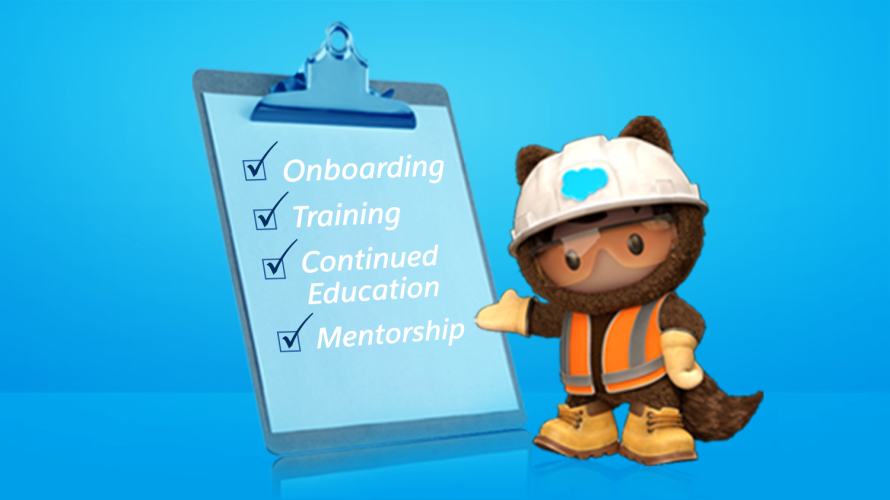You just hired a new class of field service workers to join your mobile workforce. They’re promising, ambitious, and tech-savvy. You’re ready to get them in the field and expect great results.
Not so fast: One training early on won’t do it. In addition to new safety challenges presented by changing times, technological advancements and ever-rising customer expectations continue to push today’s field service workers to do more than those before them. Continued training and education have become paramount to improve skills and keep workers satisfied. One study found 87% of millennials, who are increasingly entering the mobile workforce, say professional development or career growth opportunities are very important to them in a job.
Without an investment in growth, they may leave — and service organizations can’t afford that. To retain your mobile workforce and fuel growth, here’s how to create a recurring training and education program that empowers every mobile field service worker.
1. Take time to build a career roadmap
Today’s mobile workforce wants control of their careers — and wants to know what they need to excel. For successful workforce management, have field service workers set a mix of skills-based technical goals and customer service goals at the time of hire. On a periodic basis, return to these goals to reflect on progress, make adjustments, and evolve based on new areas of interest.
- Short-term goals are measured in months to track results.
- Long-term goals are measured in years to help employees identify where they see themselves going within your company — and what it takes to get there.
2. Build technical proficiency with guided learning
Legacy workers with specific technical skills and years of experience are aging out. While new hires may not have the exact skills for your asset, piece of equipment, or service out the gate, technical proficiency can be learned.
Use one type or a mix of training approaches, including instructor-led, live online training, and self-paced online training. Digital learning resources, in particular, have several advantages. They enable field service workers to follow a mandatory curriculum, including safety requirements, as well as go above and beyond to learn additional skills based on their interests. They enable field service workers to follow a mandatory curriculum, as well as go above and beyond to learn additional skills based on their interests. Not to mention, it’s a faster, more effective way to learn. They can even reference lessons later when on the job through a digital knowledge base.
3. Get everyone trained on your technology
Even though your new hires know how to use apps from their favorite retailers and can text at lightning speed, it doesn’t necessarily mean they know how to work your field service app. Ensure all mobile field workers, new and existing, are trained on your connected field service solution.
- Begin by getting everyone up and running with the basics. Set training milestones workers should meet periodically.
- After the basics, train employees on best practices, advanced features, and how to troubleshoot any inefficiencies that emerge as they use your system.
- Set regular training meetings — for example, quarterly — to address learning needs and get workers up to speed on updates to your system.
- Maintain digital learning how-to videos in a knowledge base for workers to reference on an ongoing basis.
4. Think beyond the technical to support career growth
Career success isn’t just about technical skills anymore. Create additional learning opportunities that empower field service workers to better connect with customers and shape their leadership skills.
- Customer relations training boosts soft skills. Conduct role-playing exercises and have employees weigh in with constructive feedback.
- Sales training teaches workers how to identify upsell and cross-sell opportunities in the field. More organizations are prioritizing selling abilities: 79% of service leaders now say mobile service provides new revenue streams.
- Management training helps workers move up from the field-tech level who may not have existing management experience.
5. Create a sense of community with peer-to-peer learning
Field service workers spend a lot of their workdays alone. The solitary experience can contribute to a lack of engagement and high turnover. Address this by creating a community of mobile field workers who can learn from each other.
- Your existing workers are a fountain of information. Create a job shadowing program for new hires to learn from the best in a real-life service scenario. This can be done virtually with video.
- Tap employees with demonstrated leadership skills to participate in a mentoring program. They can share their experiences and offer guidance to new and existing field service workers in your mobile workforce. Chat is an easy way for mentors and mentees to keep the conversation going — no matter where they’re located.
- Consider offering training days with best-in-class teams from other organizations, even in different industries. Your field service workers can learn a lot from overarching customer service best practices from brands in the retail, consumer goods, and even travel space. Be sure to develop training programs that can be conducted in person or via video conferencing.
6. Offer an ongoing certification program
While it may not have been on a company’s radar to offer certifications to their field service team in years past, a certification program ensures your team gets the right mix of functional and technical skills. Employees can advance their roles in your organization by taking courses and leveling up their expertise on a regular basis
You never want to hear “I quit” or “I’m leaving for a competitor” from your best field service workers. Make retention a priority with the best training and education program that powers short- and long-term career success. Start with the basics of mobile workforce management on Trailhead, our free learning and certification tool, with helpful modules on how to map workflows and track preventative maintenance.
















![[Customer service career path]: A picture of Shonnah Hughes smiling in her maroon Serviceblazer hoodie](https://www.salesforce.com/blog/wp-content/uploads/sites/2/2024/06/Serviceblazer-Shonnah-Hughes.jpg?w=128&h=96&crop=1&quality=75)











